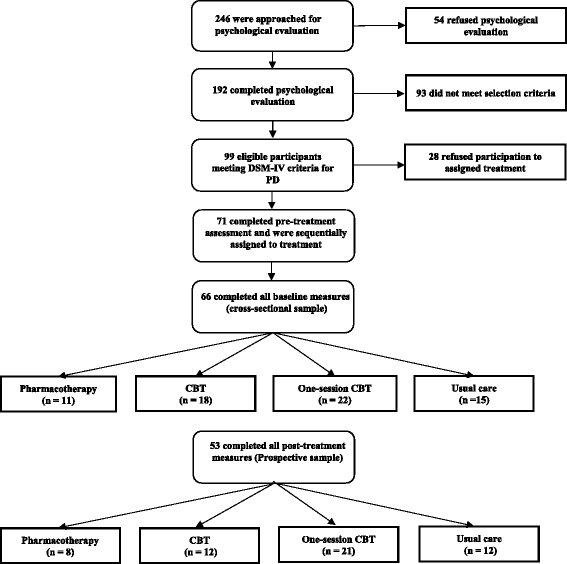Factors associated with pain level in non-cardiac chest pain patients with comorbid panic disorder
- PMID: 27777612
- PMCID: PMC5070074
- DOI: 10.1186/s13030-016-0081-5
Factors associated with pain level in non-cardiac chest pain patients with comorbid panic disorder
Abstract
Background: Panic disorder (PD) is highly prevalent in patients with non-cardiac chest pain (NCCP). This study aims to explore the role of psychological factors (PD intensity, anxiety sensitivity, heart-related fear, attention and avoidance) common to NCCP and PD in predicting chest pain levels in patients with both conditions.
Methods: This association was investigated in emergency department patients with NCCP and PD receiving either evidence-based treatment of PD or treatment as usual. Patients were assessed at baseline and 14 weeks later for post-treatment.
Results: Only heart-focused fear and attention for cardiac sensations independently explained a significant portion of the variance in baseline pain (n = 66). At 3 months follow-up (n = 53), changes in heart-related fear was the only factor independently associated with changes in chest pain intensity. Even in patients with PD, fear specific to cardiac sensations seems to play a central role in determining NCCP intensity.
Conclusion: These results suggest that the efficacy of intervention for patients with PD and comorbid NCCP could be improved by targeting heart-related fear and attention.
Trial registration: NCT00736346.
Keywords: Anxiety sensitivity; Cardiac anxiety; Chest pain; Heart-focused anxiety; Non-cardiac chest pain; Panic disorder.
Similar articles
-
Anxiety disorders in patients with noncardiac chest pain: association with health-related quality of life and chest pain severity.Health Qual Life Outcomes. 2022 Jan 10;20(1):7. doi: 10.1186/s12955-021-01912-8. Health Qual Life Outcomes. 2022. PMID: 35012545 Free PMC article.
-
Are Patients at Risk for Developing Panic Disorder After an Emergency Department Visit With Noncardiac Chest Pain?J Acad Consult Liaison Psychiatry. 2022 Jan-Feb;63(1):23-31. doi: 10.1016/j.jaclp.2021.07.011. Epub 2021 Aug 2. J Acad Consult Liaison Psychiatry. 2022. PMID: 34352451
-
Depressive Symptoms, Cardiac Anxiety, and Fear of Body Sensations in Patients with Non-Cardiac Chest Pain, and Their Relation to Healthcare-Seeking Behavior: A Cross-Sectional Study.Patient. 2016 Feb;9(1):69-77. doi: 10.1007/s40271-015-0125-0. Patient. 2016. PMID: 25840677
-
Non-cardiac chest pain: a 2018 update.Minerva Cardioangiol. 2018 Dec;66(6):770-783. doi: 10.23736/S0026-4725.18.04681-9. Epub 2018 Apr 11. Minerva Cardioangiol. 2018. PMID: 29642692 Review.
-
How do we define non-cardiac chest pain?J Gastroenterol Hepatol. 2005 Dec;20 Suppl:S2-5. doi: 10.1111/j.1440-1746.2005.04164.x. J Gastroenterol Hepatol. 2005. PMID: 16359344 Review.
Cited by
-
Which symptoms are the psychopathological core affecting the manifestation of pseudo-cardiac symptoms and poor sleep quality in young adults? Symptoms of personality disorders versus clinical disorders.Front Psychol. 2022 Dec 9;13:1011737. doi: 10.3389/fpsyg.2022.1011737. eCollection 2022. Front Psychol. 2022. PMID: 36571031 Free PMC article.
-
Anxiety disorders in patients with noncardiac chest pain: association with health-related quality of life and chest pain severity.Health Qual Life Outcomes. 2022 Jan 10;20(1):7. doi: 10.1186/s12955-021-01912-8. Health Qual Life Outcomes. 2022. PMID: 35012545 Free PMC article.
-
Biobehavioral approach to distinguishing panic symptoms from medical illness.Front Psychiatry. 2024 May 8;15:1296569. doi: 10.3389/fpsyt.2024.1296569. eCollection 2024. Front Psychiatry. 2024. PMID: 38779550 Free PMC article. Review.
-
Physical activity and disability in patients with noncardiac chest pain: a longitudinal cohort study.Biopsychosoc Med. 2020 Jun 30;14:12. doi: 10.1186/s13030-020-00185-9. eCollection 2020. Biopsychosoc Med. 2020. PMID: 32612673 Free PMC article.
-
The role of hypervigilance in chronic esophageal diseases: a scoping review.Transl Gastroenterol Hepatol. 2024 Jun 17;9:44. doi: 10.21037/tgh-23-120. eCollection 2024. Transl Gastroenterol Hepatol. 2024. PMID: 39091656 Free PMC article.
References
-
- Potts SG, Bass CM. Psychosocial outcome and use of medical resources in patients with chest pain and normal or near-normal coronary arteries: a long-term follow-up study. Q J Med. 1993;86(9):583–93. - PubMed
Associated data
LinkOut - more resources
Full Text Sources
Other Literature Sources
Medical


